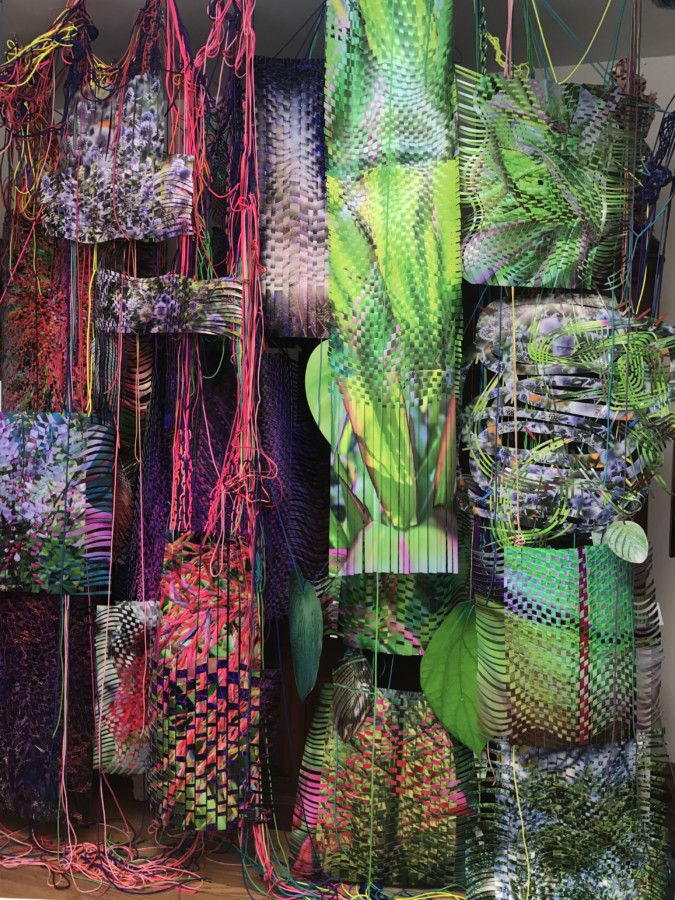Aimée Beaubien: Twist Affix
@ Riverside Arts Center Freeark Gallery + Sculpture Garden
32 E Quincy St, Riverside, IL, 60546
Opening Sunday, October 29th, from 3PM - 6PM
On view through Saturday, December 2nd
Join us for the opening reception of “Aimée Beaubien: Twist Affix.” This solo exhibition of new work by the Chicago-based artist consists of several large-scale installation pieces that combine photography, collage, installation and weaving practices and is inspired by botany, backyard gardens, the act of collecting and the weight of things, images, memories and emotions.
“Leaning, shooting, bedded, staked, staying. Drooping, reclining, pitched, and placed. Sloping, jutting, braced. Holding, heaped. Planted and spread. My recent collage-based installations map networks of meaning and association between the garden, the ephemeral, and the photographic. Qualities of the garden run parallel to the nature of photography: they are spaces defined by interactions of the scientific, the accidental, and the temporal.
In my garden installations, cut forms interweave, encircle, and hang; trail in ribbon-like shreds; and become wild ornamental outgrowths. Hothouse grow lights create plays of intensely colored light and shadow; an oscillating household fan may keep these enmeshed forms actively swaying with life.
My collage practice is driven by the translational space between image and material, and by generative and cumulative strategies of making. I embrace the documentary capacity of the camera, recording what I encounter. My images become printed photographs, then sculptural forms. Cutting and reassembling, I draw with scissors.
Photographic paper is my sculptural material. Through it, I explore physical and perceptual relationships. Within the visual and temporal entanglements of my installations, perception slips between recognition and abstraction: from a sky, a topography, or a textile, into fields of color and pattern and back again.
Immaculately tended or grown wild; in public space or as private refuge, gardens are collections. They are the products of migration, accumulation, curation, and caprice. Culled from the orderliness of scientific taxonomies, we assemble our gardens for aesthetic pleasures, and for contact with wildness.
Our hours spent in leisure or in the attentive labor of cultivation are hours spent contemplating temporal bodies. In the botanical, we watch biological time, reproduction, death, and renewal. In the fragile and heavy shapes of blooms, we find the erotic. Heat, moisture, light, earthy fragrance, soft din of ambient sound: a bouquet of the sensory.
In the store of family pictures I have inherited, it is evident that my great-grandmother photographed her garden throughout the seasons and her lifetime. Now I photograph in my tiny backyard garden, in my mother’s amazing garden in Florida, and in the botanical gardens near each of our homes. In these spaces, varied life cycles move at different speeds: interdependent systems bloom, grow, intertwine, and die. Gardens portray time.
My studio is on the first floor of my home, and the garden is out back. Wild, fast growing vines creep about the garage, slink through the yard and climb all around our house. I have noticed my domestic environment influences my work in unexpected ways. Last summer I began pulling out thickly entwining morning glories, plucking the heart shaped leaves and rolling them up into large tumbleweeds. In my studio, the hanging dried and drying plants mingle with huge tangles of cut and woven photographic pieces that dangle down from the ceiling.
I often allow everyday objects from my domestic space to become integrated into the structure of my sculptures and installations. Surrounded by suspended, propped, and perched objects, I consider perceptions of weight: the weight of things, the weight of images, the weight of representations, and the emotional ties interlaced throughout.
I am captivated by many different types of collections, from the significant objects curated and presented by museums to idiosyncratic displays in homes. My photographs are often made in institutional exhibits of art and artifacts, in quirky home museums, in urban plant conservatories, and in my domestic space. As I work in the studio, I jot down fragmentary impressions of what I am making. Titles evolve from these sketches, encouraged by William S. Burroughs cut-up techniques. My titles are collages in text. These transformations – cutting up visual material, making associations, writing, then cutting and fashioning new written forms – mirrors the iterative, recombinatory process of my site-conscious installations.” — Aimée Beaubien
Official Website
More events on this date
Tags: Aimee Beaubien, Riverside, Riverside Arts Center Freeark Gallery + Sculpture Garden, Twist Affix

« previous event
next event »